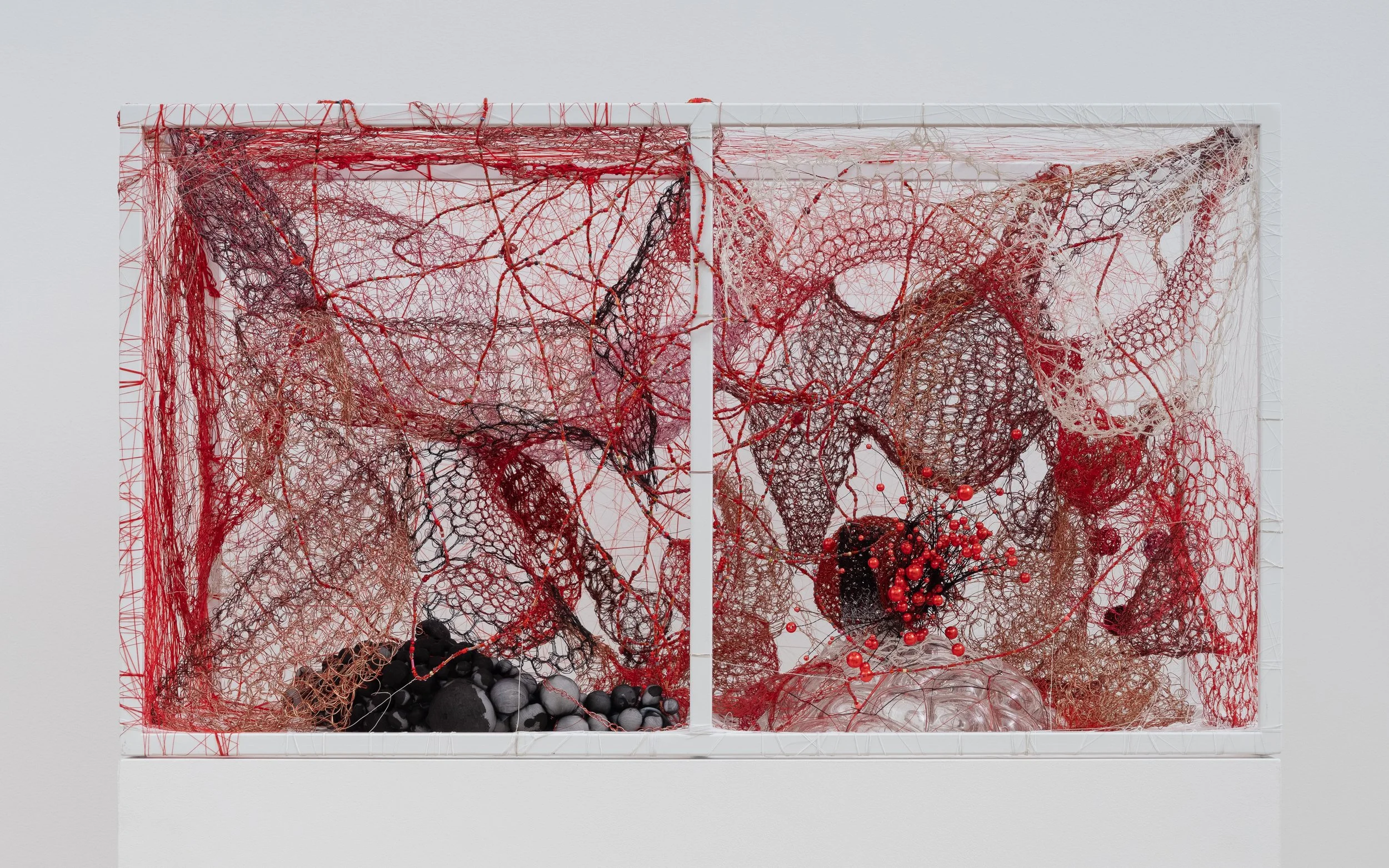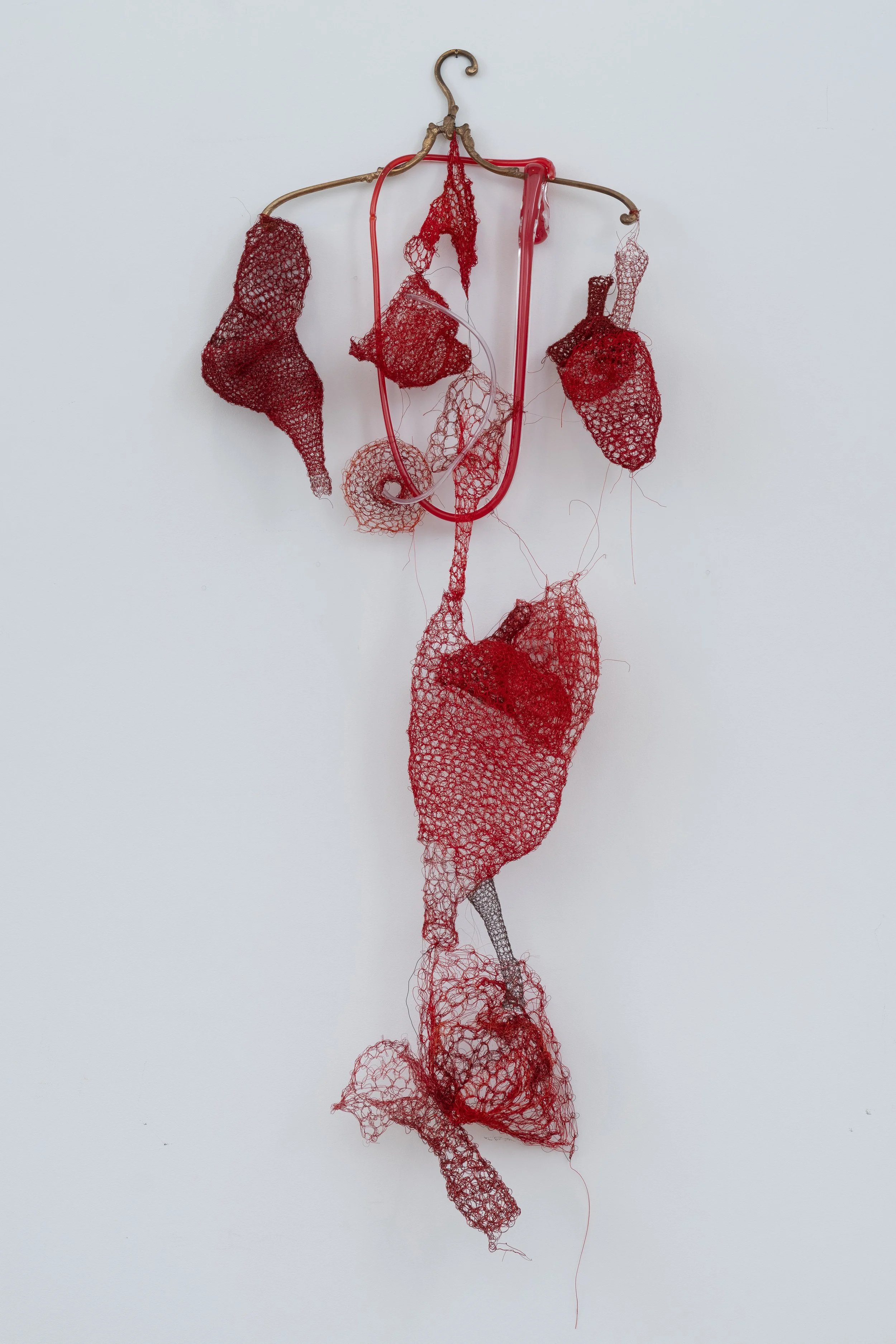In Conversation with Chiharu Shiota
CHIHARU SHIOTA Endless Line, 2025 Fil sur toile | Thread on canvas 140 × 240 cm — 55 × 94 1/2 in Courtoisie de l'artiste et Templon, Paris – Bruxelles - New York | Courtesy of the artist and Templon, Paris – Brussels - New York Photo © Charles Roussel
Born in Osaka, Japan, in 1972, Chiharu Shiota has been living and working in Berlin for over two decades. Her work has been featured in numerous solo exhibitions and is presented on every continent.
In 2015, she represented Japan at the Venice Biennale, earning international acclaim. Since then, her work has been exhibited at the Museum of Kyoto (Japan, 2018), the Göteborg Museum of Art (Sweden, 2018), the Gropius Bau in Berlin (Germany, 2019), the Mori Art Museum in Tokyo (Japan, 2019), the Fondazione Merz in Turin (Italy, 2020), the Gwangju Biennale Foundation (South Korea, 2021), the Centro Cultural Banco do Brasil in Rio de Janeiro (Brazil, 2021), the Taipei Fine Arts Museum (Taiwan, 2021), Manifesta 14 (Kosovo, 2022), the Musée Guimet in Paris (France, 2022), the Queensland Art Gallery of Modern Art in Brisbane (Australia, 2022), the K11 Museum in Hong Kong (2022), the Shenzhen Art Museum (China, 2023), the Hammer Museum in Los Angeles (United States, 2023), the Grand Palais in Paris (France, 2024), the Fundació Antoni Tàpies in Barcelona (Spain, 2024), the Institute of Contemporary Art in Boston (United States, 2025), and the Japan Society in New York (2025).
I had the pleasure and the honor of asking Chiharu about what they would be doing if they were not an artist, their upcoming exhibition at Templon Gallery, and so much more.
UZOMAH: Having published books about your art, can you describe the importance of non-censorship in publishing books, not just in the visual arts, but in literature as a whole?
CHIHARU: Being able to publish catalogues is very important for an artist. You can see an artist’s whole life, from the beginning to the present, through their catalogues. I still remember when I published my first solo catalogue at the Württembergischer Kunstverein Stuttgart in 2003.
It was such a special moment for me and for others to finally hold it in our hands. I haven’t had any issues with censorship in publishing books so far. My work is not political, it is more poetic and personal, about life itself.
U: You have an upcoming exhibition at Templon Gallery in New York. How did the collaboration between you and the gallery originate? What made you want to work with the gallery?
C: I started working with Gallery Templon more than 15 years ago. I have travelled to Paris many times over the years, and they have always been very supportive. I couldn’t have survived without them, because I can’t sell my own work — I need the support of a gallery. When they opened a gallery in New York, I was very happy that they invited me to exhibit there.
CHIHARU SHIOTA Endless Line, 2024 Fil sur toile | Thread on canvas 160 × 140 cm — 63 × 55 in Courtoisie de l'artiste et Templon, Paris – Bruxelles - New York | Courtesy of the artist and Templon, Paris – Brussels - New York Photo © Charles Roussel
U: What would you be doing if you were not an artist?
C: I cannot image not being an artist. I am an artist 24 hours every day. I think about my work until I go to sleep. If I am not an artist – I can’t exist.
U: Your inspirations often emerge from personal experiences or emotions, which she expands into universal human concerns, such as life, death, and relationships. Where did these themes come from? What part of your life did you and do you draw from to expand on them through your art?
C: These feelings come from my life. I had cancer twice in my life, and every time but especially during my chemotherapy I was thinking about death and how close it can be. I was thinking about my soul and where it would go when my body is gone, would I simply disappear? When people pass away, their memory stays. You can feel their existence even though they are absent.
U: If you could interview, have dinner, or just discuss any topic you want. What artist or writer would you choose and why?
C: I like Ana Mendieta’s work, but if she would appear in front of me and if I would talk to her and have dinner it would be different. I can see her world without langue, but I don’t know if I want to have dinner or interview with her because the artwork and the artists are different – even if I like their work, maybe I don’t like the person.
If I would choose artwork that I could hang in my home and look at every day, I would choose Self-Portrait with Bandaged Ear, 1889 . He created so much beauty from pain.
CHIHARU SHIOTA Inside Memory, 2025 Techniques mixtes | Mixed media 45 × 45 × 80 cm — 17 ¾ × 17 ¾ × 31 1/2 in Courtoisie de l'artiste et Templon, Paris – Bruxelles - New York | Courtesy of the artist and Templon, Paris – Brussels - New York Photo © Charles Roussel
U: Tapping into the sensation of a 'presence in the absence' with your installations, which also present intangible emotions in your sculptures, drawings, performances, and canvases. Could you explain more about this concept and how you use space between objects and the placement of objects to show the presence or absence?
C: For the exhibition, I am using two chairs because for me the objects that surround us accumulate our memory. So, I don’t see a chair, I see a person, two people sitting with each other, maybe having a conversation. Every object represents a person. I don’t know them, but I can feel their existence. This time I am using a textile light and butterflies. In Asia, it is said that butterflies represent the souls of people. It is a symbol of death but also life.
CHIHARU SHIOTA Forgotten Memories, 2025 Techniques mixtes | Mixed media 135 × 55 × 20 cm — 53 ¼ × 21 ¾ × 7 3/4 in Courtoisie de l'artiste et Templon, Paris – Bruxelles - New York | Courtesy of the artist and Templon, Paris – Brussels - New York Photo © Charles Roussel
U: As an artist, how do you see your art as a part of society and having a role in active change through the creation of your art?
C: Art is always part of society, and I want to give the audience something different from normal life. When they come to the museum, suddenly they are confronted with a different idea of life or of the world, they experience more freedom or another perspective.
U: Which artists and writers have influenced your artistic process?
C: When I was 12 years, there was a special page in every Sunday that introduced an artwork and the meaning behind it. For example, Munch’s Scream. I would always cut out the image and collect them in a folder. This was so fascinating to me; all these artists made me more involved in the artworld. They were more traditional like Van Gogh, and Munch and later I learned about Ana Mendieta, Louise Bourgeois, and Yayoi Kusama.
CHIHARU SHIOTA Connected to the Universe, 2025Peinture à la cire hydro-soluble, encre et fil sur toile | Water-soluble wax pastel, ink and thread on paper 76 × 56 cm — 30 × 22 in (non encadré | unframed) 84 × 63.5 × 2.5 cm — 33 × 25 × 1.5 in (encadré | framed) Courtoisie de l'artiste et Templon, Paris – Bruxelles - NewYork | Courtesy of the artist and Templon, Paris – Brussels -New York Photo © Charles Roussel
U: What is the best advice you have received about your art?
C: I am artist, I don’t like to listen to advice too much. When I was studying, it was hard for me to do homework because my professors wanted me to follow certain topics or themes. But I wanted to make art in my own way, with my own ideas. So I didn’t listen much to what others told me to do.
CHIHARU SHIOTA State of Being (Boat), 2025 Cadre en métal, fil | Metal frame, thread 150 × 100 × 15 cm — 59 × 39 ¼ × 6 in Courtoisie de l'artiste et Templon, Paris – Bruxelles - New York | Courtesy of the artist and Templon, Paris – Brussels - New York Photo © Charles Roussel
U: How do you think the viewer should feel when looking at your art? Do you create so that your viewer takes away a particular perspective about the themes you address?
C: I think the audience has to be free to feel whatever they want, there is no single or simple answer to my artwork, or to art in general. When 400 people see the installation, each person will have a different opinion or experience. If someone is very interested, they might read my concept; if not, they may just walk through. Maybe they don’t feel anything, and that’s also okay. How long they spend in the museum, and how deeply they engage with my work, is completely up to them. It’s not like in a theatre or play, where the experience is directed and structured.
For more information about Chiharu’s artwork, please visit her site here. She can also be found on Instagram and Facebook. The magazine also did a feature on Chiharu’s latest exhibition at Templon Gallery, which can be found here.





